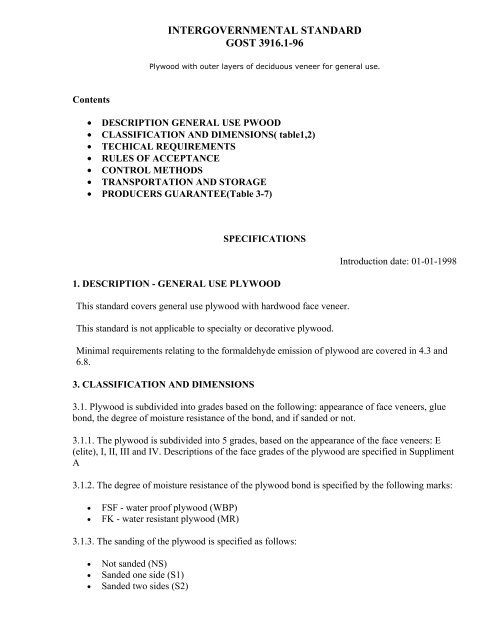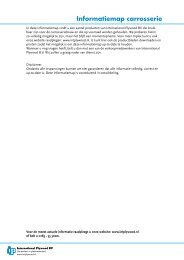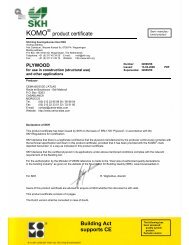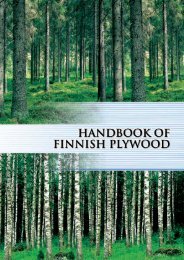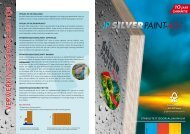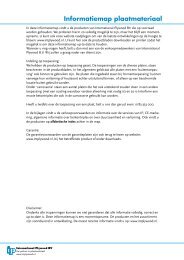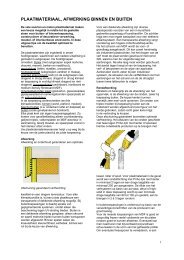INTERGOVERNMENTAL STANDARD GOST 3916.1-96
INTERGOVERNMENTAL STANDARD GOST 3916.1-96
INTERGOVERNMENTAL STANDARD GOST 3916.1-96
Create successful ePaper yourself
Turn your PDF publications into a flip-book with our unique Google optimized e-Paper software.
<strong>INTERGOVERNMENTAL</strong> <strong>STANDARD</strong><strong>GOST</strong> <strong>3916.1</strong>-<strong>96</strong>Plywood with outer layers of deciduous veneer for general use.Contents• DESCRIPTION GENERAL USE PWOOD• CLASSIFICATION AND DIMENSIONS( table1,2)• TECHICAL REQUIREMENTS• RULES OF ACCEPTANCE• CONTROL METHODS• TRANSPORTATION AND STORAGE• PRODUCERS GUARANTEE(Table 3-7)SPECIFICATIONSIntroduction date: 01-01-19981. DESCRIPTION - GENERAL USE PLYWOODThis standard covers general use plywood with hardwood face veneer.This standard is not applicable to specialty or decorative plywood.Minimal requirements relating to the formaldehyde emission of plywood are covered in 4.3 and6.8.3. CLASSIFICATION AND DIMENSIONS3.1. Plywood is subdivided into grades based on the following: appearance of face veneers, gluebond, the degree of moisture resistance of the bond, and if sanded or not.3.1.1. The plywood is subdivided into 5 grades, based on the appearance of the face veneers: E(elite), I, II, III and IV. Descriptions of the face grades of the plywood are specified in SupplimentA3.1.2. The degree of moisture resistance of the plywood bond is specified by the following marks:• FSF - water proof plywood (WBP)• FK - water resistant plywood (MR)3.1.3. The sanding of the plywood is specified as follows:• Not sanded (NS)• Sanded one side (S1)• Sanded two sides (S2)
3.2. Dimensions.3.2.1. The dimensions and the number of plies in the plywood sheets must correspond to tables 1and 2.Table 1. Dimensions (millimeters)Length(width) of the plywood sheets Min(Max)Tolerance in mm1200,1220,1250 +/- 3,01500,1525,1800,1830 +/- 4,02100,2135,2440,2500 +/- 4,02700,2745,3050,3600,3660 +/- 5,0Note: Production of plywood is allowed in other dimensions corresponding with the termsof a contract.NominalNumberthicknessof pliesof plywoodTable 2. Thickness (millimeters)Sanded PlywoodToleranceMin/Max(mm)Sanded PlywoodThicknessVariance(mm)UnsandedPlywoodToleranceMin/Max(mm)UnsandedPlywoodThicknessVariance(mm)3,0 mm 3-ply + 0,3/-0,4 + 0,4/-0,3 0,64,0 mm 3-ply + 0,3/-0,5 + 0,8/-0,46,5 mm 5-ply + 0,4/-0,5 + 0,9/-0,4 1,09,0 mm 7-ply + 0,4/-0,6 + 1,0/-0,512,0 mm 9-ply + 0,5/-0,7 0,6 + 1,1/-0,615,0 mm 11-ply + 0,6/-0,8 + 1,2/-0,718,0 mm 13-ply + 0,7/-0,9 + 1,3/-0,821,0 mm 15-ply + 0,8/-1,0 + 1,4/-0,9 1,524,0 mm 17-ply + 0,9/-1,1 + 1,5/-1,027,0 mm 19-ply + 1,0/-1,2 1,0 + 1,6/-1,1 2,030,0 mm 21-ply + 1,1/-1,3 + 1,7/-1,2
Note: Production of plywood is allowed in other thickness and construction (number of plies)corresponding with the terms of a contract. The minimum and maximum variances may bedetermined by the following formula.Sanded Plywood - maximum/minimum tolerance:1. Maximum: Thick * 0.03 mm + 0.2 mme.g. (12 mm*0.03 mm + 0.2 mm) = 12 mm + 0.5 mm2. Minimum: Thick * 0.03 mm + 0.4 mme.g. (12 mm*0.03 mm + 0.4 mm) = 12 mm - 0.7 mmUnsanded Plywood - maximum/minimum tolerance:1. Maximum: Thick * 0.03 mm + 0.8 mme.g. (12 mm*0.03 mm + 0.8 mm) = 12 mm + 1.1 mm2. Minimum: Thick * 0.03 mm + 0.4 mme.g. (12 mm*0.03 mm + 0.3 mm) = 12 mm - 0.6 mm3.2.2. Plywood panels must be cut at a right angle. Deviation must not exceed 2 mm per 1lineal meter.3.2.3. Deviation from square edges can not exceed 2mm per 1 lineal meter.3.3. Marking if plywood must include:• Name of product• Wood species of the face and core veneers• Glue Bond marks• Veneer grades of the face layers• Formaldehyde emission classification• Type of surface treatment• Dimensions• Applicable <strong>GOST</strong> standardBelow is an example of marking of birch plywood with core plies of birch veneer, waterresistant, with a combination of face veneers I/III, with an emission class of E1, sanded bothsides, 2440 mm long, 1220 mm wide and 9 mm thick:Plywood birch /birch, FK (MR), I/III, E1, S2, 2440*1220*9 <strong>GOST</strong> <strong>3916.1</strong>-<strong>96</strong>4.TECHNICAL REQUIREMENTS4.1. Characteristics4.1.1. The following species can be used for the face veneer: birch, alder, maple, elm, beech,
aspen, poplar, lime. For core veneers, in addition to the ones just mentioned, the followingcan be used: pine, spruce, fir, larch and cedar.The timber used for face veneers of plywood determines the species of the plywood.The plywood can be made of one or more than one species of wood, therefore it is either"homogeneous" or "combined".If the number of veneer plies is even, the direction of fibers (grain) of the two middle pliesmust be parallel.Veneers, located symmetrically within the thickness of plywood, must be of the same speciesand thickness.The thickness of the face veneers must not exceed 3,5 mm and the thickness of core veneersmust not exceed 4 mm.4.1.2. Wood and manufacturing defects exceeding limits stated in Table3 are not allowed inface veneers.4.1.3. Wood and manufacturing defects, exceeding the limits stated in Table3, are allowed incore veneers, as long as they do not influence its integrity and dimensions. The requirementsfor quality and dimensions are specified in this standard.4.1.4. The maximum amount of wood and manufacturing defects allowed in face veneers isindicated in Table 4.4.1.5. The combination of face veneer grades is indicated in <strong>GOST</strong> 30427.4.1.6. The face veneer of grade E can consist of 2 veneer strips with one joint in the middleof the sheet. This applies only to widths less than 1525 mm.If the width is 1525 mm, the face veneer of grade E can consist of 3 strips of equal width.The face veneer of grades I and II can be made from an unlimited number of veneer strips.For grades E, I, II veneer joints must be parallel to plywood edges and veneer strips mustmatch in color.4.1.7. Plugs must fit the surface, be firmly bonded, must match the color of the face veneerand its grain direction. For grades I and II the plugs must match the color of the wood.Putty fillers or repairs must match the color of the wood species of the given grade. Inaddition, they must provide easy gluing of the facing materials, must not crumble out orcrack during plywood processing or bending.4.2. Strength and mechanical indices are stated in Table 5.4.3. Plywood formaldehyde content, depending on emission class, must meet the limitsstated in Table 6.4.4. The plywood is measured in either square meters or cubic meters. The volume of onepanel is determined with a precision of up to 0.00001 m3. The volume of a plywood lot isdetermined with a precision of up to 0.01 m3. The surface area of a panel is measured withthe precision of up to 0.01 m2. The surface area of a plywood lot is measured with aprecision of up to 0.5 m2.4.5. The marking is stamped with indelible paint on the back side of every panel statingplywood grade and inspector's number.
Marks of bundles or crates of plywood contain:• Name of the plywood-producer country• Name of mill-producer and/or its trade mark• Conventional plywood marking• Number of panels in the bundle• National mark of conformity for certified production• Transportation marking is in accordance with <strong>GOST</strong> 14192.4.6. Packaging.4.6.1. Plywood must be packed in bundles weighting no more than 1500 kgs. It has to beseparated according to species, glue bond, grades, glue emission classes, types of surfacetreatments and dimensions.If parties mutually agree and in accordance with a sales contract, plywood can be packed inbundles of other weight.4.6.2. If plywood id to be shipped to regions in the Extreme North or other difficult-to-reachregions, it has to be packed according to 4.6.1. and <strong>GOST</strong> 15848.5. RULES OF ACCEPTANCE5.1. Plywood is accepted in lots.A lot consists of plywood of the same species, the same glue bond, the same grade, the sameglue emission class, and the same type of surface treatment and panel dimensions.There should be one document for each lot, specifying quality and containing:• Name of the country-producer• Name of the mill-producer and (or) its trade mark• Conventional plywood marking• Volume or square meters of panels in the lot• Stamp of technical control• National mark of conformity for a certified production5.2. Quality and dimensions of panels are subject to random inspection. If specified in a salescontract (agreement), specific lots may be subject to full inspection.In a random inspection, sheets are selected indiscriminately in accordance with <strong>GOST</strong> 18324and confirming the quantities, mentioned in Table 7.5.3. Shear, tensile and static bending strengths are checked for plywood of every glue bond,thickness and plies construction at least once a month. In accordance with sales contracts(agreements), it is permitted to select 0.1 % of sheets in every lot, but not less than one sheet.5.4. Formaldehyde emission is checked every 30 days for FSF (WBP) plywood and every 15days for FK (MR) plywood. In accordance with terms of sales contract, a check may be doneevery 7 days.5.5. A lot is considered to meet the requirement of the current standard and is accepted, if inthe random inspection the following is confirmed:
• number of plywood sheets which are not meeting the requirements of the currentstandard due to dimensions, out of square, linear edges, wood and manufacturingdefects is LESS or EQUAL to the accepted amount, which is stated in Table 7.• all sheets of plywood must have no bubbles, no delamination and no trace of bark• formaldehyde emission corresponds to the norms defined in Table 66. CONTROL METHODS6.1. Selection of samples for strength and mechanical tests is made in accordance with<strong>GOST</strong> <strong>96</strong>20. Selection of samples for formaldehyde emission tests is made in accordancewith <strong>GOST</strong> 27678.6.2. The length and width is measured at two points in the same panel, which are parallel tothe edges and are located at least 100 mm from the edges. The measurements are done with ametal tape, which has an index error of 1 mm or less in accordance with <strong>GOST</strong> 7502.Measurements have to be taken twice and the actual length (width) of the sheet would betheir average.6.3. Thickness is measured at a distance of at least 25 mm from the edges. Thickness also hasto be measured at the middle of each side of the panel with a thickness meter as per <strong>GOST</strong>11358, or with a micrometer with a scale division of at least 0.1 mm in accordance with<strong>GOST</strong> 6507.Measurements of thickness have to be taken 4 times and the actual thickness would be anaverage of those 4 measurements.The difference in thickness in one panel of plywood is determined as a difference betweenthe maximum and minimum thickness from these 4 measurements.6.4. Moisture content is determined in accordance with <strong>GOST</strong> <strong>96</strong>21.6.5. Shear strength along the glue line is determined in accordance with <strong>GOST</strong> <strong>96</strong>24.6.6. Static bending strength is determined in accordance with <strong>GOST</strong> <strong>96</strong>256.7. Tensile strength is determined in accordance with <strong>GOST</strong> <strong>96</strong>626.8. Formaldehyde emission is determined in accordance with <strong>GOST</strong> 276786.9. Roughness of the surface is determined in accordance with <strong>GOST</strong> 156126.10. Wood and manufacturing defects are measured in accordance with <strong>GOST</strong> 304276.11. Deviation from linear edges of plywood panel is determined by measuring themaximum gap between the panel edge and metal ruler edge with a probe in accordance with<strong>GOST</strong> 8925 and within an index error of 0,2 mm.6.12. Measurements for obliquity (out of square) are determined in accordance with <strong>GOST</strong>30427.
7. TRANSPORTATION AND STORAGE7.1. Plywood is transported in covered vehicles, in accordance with the transportationconsignment rules for the given means of transport.7.2. Transportation and storage of plywood, which is to be shipped to the Extreme North ordifficult-to-access regions, is in accordance with <strong>GOST</strong> 15846.7.3. Plywood is stored in horizontally stacked bundles, on pallets or on wooden supportsticks, indoors, at a temperature ranging from -40C up to +50C at the humidity not exceeding80%.8. PRODUCERS GUARANTEEProducers guarantee that the plywood quality conforms to the current <strong>GOST</strong>, provided theproper transportation and storage conditions.FK (MR) plywood has a storage guarantee of 3 years and FSF (WBP) plywood has a storageguarantee of 5 years from the delivery date.TABLE 3. DESCRIPTION AND LIMITATIONS OF PLYWOOD DEFECTSDescription ofwood andmanufacturingdefects acc. to<strong>GOST</strong> 30427Grade Eplywood faceveneersGrade Iplywood faceveneersGrade IIplywood faceveneersGrade IIIplywood faceveneersGrade IVplywood faceveneers1.Pin knotsNot allowedMax 3 per m2allowedAllowed Allowed Allowed2.Sound accretelight and darkknotsNot allowedUp to 5 per m2, max. 15mmin diam. withcracks max.0,5mm wideUp to 10 perm2 , max.25mm in diam.with cracksmax. 1 mmwideAllowed withcracks max.1,5mm wideAllowed3.Partly accreteor single knots,loose knots, knotholes, wormholesNot allowedUp to 3 perm2, max 6mmin diam.Up to 6 perm2, max 6mmin diam.Up to 10 perm2, max 6mmin diam.No limit, max40 mm indiam.4.Closedcracks/splitsNot allowedUp to 2 per 1m width of aplywood sheet,max 200mmlongUp to 2 per 1m width of aplywood sheet,max 200mmlongAllowedAllowed
5.Opencracks/splitsNot allowedNot allowedMax. 2, up to200 mm long,max. 2 mmwide, oncondition theyare putty filledMax. 2, up to300 mm long,max. 2 mmwide, allowedup to 600 mmlong, max. 5mm wide oncondition theyare putty filledAllowed withno limitationin length andin number,max. 10 mmwide6.Light inbark Not allowed Allowed Allowed Allowed Allowed7.Dark inbark Not allowed Not allowed8.Deviation inwood structure9.Sound stain(color variation)10.Unsoundstain ( colorvariation)Allowed veryinsignificant,of incidentalnature, exceptdark eyeletsNot allowedGeneralnumberallowed as peritem 2 ofpresent tableGeneralnumberallowed as peritem 2 ofpresent tableAllowedAllowed Allowed Allowed AllowedAllowed, nomore than 5%of the sheetsurfaceAllowed Allowed AllowedNot allowed Not allowed Not allowed Not allowed Allowed11.Decay Not allowed Not allowed Not allowed Not allowed Not allowed12.Pinholes13.Veneeroverlaps in outerlayers14.Lack ofveneer, defectsof panel edgesdue to sanding orsquaring(sawing)Not allowedNot allowedNot allowedGeneralnumberallowed as peritem 3 ofpresent tableNot allowedAllowed witha width of nomore than2mmGeneralnumberallowed as peritem 3 ofpresent tableAllowed 1overlap, max.100 mm longper 1m ofpanel widthAllowed witha width of nomore than4mmGeneralnumberallowed as peritem 3 ofpresent tableAllowed up to2 overlaps,max. 200 mmlong per 1mof panel widthAllowed witha width of nomore than4mmGeneralnumberallowed as peritem 3 ofpresent tableAllowedAllowed witha width of nomore than5mm15.Presense ofglue tapeNot allowedNot allowedAllowed innon-sandedplywoodAllowed innon-sandedplywoodAllowed innon-sandedplywood
16.GluepenetrationNot allowedNot allowedAllowed nomore than 2%of panelsurfaceAllowed nomore than 5%of panelsurfaceAllowed17.Scratches Not allowed Not allowed Allowed Allowed Allowed18.Indentations,imprints, combNot allowedNot allowed19.Torn grain Not allowed Not allowed20.Sandingthrough21.Warping22.Metalinclusions23.Gap in veneerjoint24.Delamination,bubbles, bark25.Waviness (forsandedplywood),fluffiness, ripple26.SurfaceroughnessAllowed ifdepth/height isin range ofthicknesstoleranceAllowed nomore than 5%of panelsurfaceAllowed ifdepth/height isin range ofthicknesstoleranceAllowed nomore than15% of panelsurfaceAllowedAllowedNot allowed Not allowed Not allowed Not allowed AllowedDoes not applyto thicknessunder 6,5mm.For 6,5 andthicker thenallowed with asag of max.15mm over1m of panel'sdiagonallengthDoes not applyto thicknessunder 6,5mm.For 6,5 andthicker thenallowed with asag of max.15mm over1m of panel'sdiagonallengthDoes not applyto thicknessunder 6,5mm.For 6,5 andthicker thenallowed with asag of max.15mm over1m of panel'sdiagonallengthNot allowed Not allowed Not allowedNot allowedNot allowedAllowed max.1 gap no morethan 1mmwide per 1 mof panel widthDoes not applyto thicknessunder 6,5mm.For 6,5 andthicker thenallowed with asag of max.15mm over1m of panel'sdiagonallengthColor metalstaples areallowedAllowed max.1 gap no morethan 1mmwide per 1 mof panel widthDoes not applyto thicknessunder 6,5mm.For 6,5 andthicker thenallowed with asag of max.15mm over1m of panel'sdiagonallengthColor metalstaples areallowedAllowedNot allowed Not allowed Not allowed Not allowed Not allowedNot allowed Not allowed Not allowed Allowed AllowedRoughnessparameter(Rm)is per <strong>GOST</strong>7016, max.:100 for sandedplywood and200 for nonsandedRoughnessparameter(Rm)is per <strong>GOST</strong>7016, max.:100 for sandedplywood and200 for nonsandedRoughnessparameter(Rm)is per <strong>GOST</strong>7016, max.:100 for sandedplywood and200 for nonsandedRoughnessparameter(Rm)is per <strong>GOST</strong>7016, max.:100 for sandedplywood and200 for nonsandedRoughnessparameter(Rm)is per <strong>GOST</strong>7016, max.:100 for sandedplywood and200 for nonsanded
27.WoodenplugsNot allowedNot allowedAllowed inrepair up to 8pieces for 1m2of panelAllowed withno limitsAllowed withno limits28.Overlappeddouble plugsNot allowedNot allowedAllowed nomore than 2pieces per 1m2of panelAllowedAllowedNote:• 1. Norm of manufacturing defects "lack of veneer" refers both to outer and corelayers.• 2. Wood and manufacturing defects not mentioned in Table 3 are not allowed.TABLE 4Grade of FaceVeneerEMaximum number of permitted wood and manufacturing defectsNo visible defectsI 3II 6III 9IVNumber of wood and manufacturing defects is unlimited. Limitation ondimensions is in accordance with items 3, 5, 11, 12, 14, 24 of Table 3APPENDIX AMARKING OF PLYWOOD FACE VENEERS IN THIS <strong>GOST</strong>, IN <strong>GOST</strong> 10.55-71 AND<strong>GOST</strong> <strong>3916.1</strong>-89GRADES<strong>GOST</strong> <strong>3916.1</strong>-<strong>96</strong> <strong>GOST</strong> 10.55-71 <strong>GOST</strong> <strong>3916.1</strong>-89E - AI B ABII BB BIII CP BBIV C C
TABLE 5VALUES OF PHYSICAL AND MECHANICAL INDICES FOR PLYWOOD WITHCORE VENEERS OF THE FOLLOWING SPECIES:IndexThickness(mm)Moisure content, % 3-30after boiling inwater for 1 hourafter soaking inwater for 24 hoursStatic bendingstrength alongfibres (MPa) notless thanTensile strengthalong fibers, MPa,no less thanGluebondFSFFKBirchAlder,beech,maple, elmShear strenght (MPa) not less than3-309-303-6,5Pine, larch,spruce, fir,cedarLime,aspen,poplar5-10 5-10 5-10 5-10FSF 1,5 1,2 1,0 0,6FK 1,5 1,0 1,0 0,6FSF 60 50 40 30FK 55,0 45,0 35,0 25,0FSF 40,0 40,0 40,0 40,0FK 30,0 30,0 30,0 30,0Note: Shear strength along glue line of 1.2. Mpa is permitted for birch plywood inaccordance with terms of a sales contract.TABLE 6EmissionClassE1E2Formaldehyde content in 100 grams of absolutely dry plywood mass,in mg.Up to 10, inclusiveFrom 10 to 30, inclusiveTABLE 7Volume of thelotSelectionVolumeControl indices according to points (in panels)3.2.1.; 3.2.3; 3.2.3; 4.1.2; 4.1.6; 4.1.7; 4.3Number forAcceptanceSelectionVolumeNumber forAcceptanceUp to 500 8 1 13 1501 to 1200 13 1 20 21201 to 3200 13 1 32 33201 to 10000 20 2 32 3


